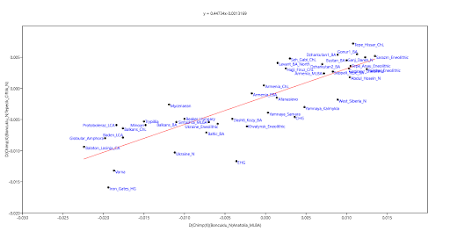I computed a series of D-statistics on most of the currently available ancient samples from Central Anatolia – dating from almost the Epipaleolithic (Boncuklu_N) to the Hittite era (Anatolia_MLBA) – to try and get a better idea of who the Indo-European-speaking Hittites may have been. The full output as well as details about the key ancient samples used in this analysis are available here. See anything interesting? The most noteworthy statistics, I suppose, are those listed below, because they’re significant (Z≥3) and organized chronologically.
However, the thing to keep in mind in regards to D-statistics, and the very similar f4-statistics, when looking for signals of mixture is that they may or may not produce significant Z scores because of several reasons, such as the choice of the outgroup, the choice of the reference sample(s) for the unadmixed population, the phylogenetic relationship between the mixed and unadmixed populations, or even the type, quality and density of the data being used.
Perhaps ironically, the D-statistics above suggest that the Neolithic Central Anatolians (Boncuklu_N and Tepecik_Ciftlik_N) were more European-like than those from the Bronze Age, and I suspect that this is one of the main reasons why the idea of Eastern European admixture (from the Pontic-Caspian steppe and/or Balkans) in Hittites is currently being rejected by the geneticists working on the problem. But this dilemma is easy to explain away by the fact that the Neolithic samples carry much higher ratios of Anatolian Epipaleolithic hunter-gatherer admixture and also other types of ancestry shared with and/or closely related to European hunter-gatherers and early farmers.
In other words, I’d say that most of the statistics are being confounded by deep phylogenetic relationships, and thus aren’t very useful for solving the Hittite problem. Interestingly, though, that relationship to Europe is reversed somewhat in the D-statistics involving Anatolia_EBA and Anatolia_MLBA, with the latter showing significantly higher affinity to Eastern European Hunter-Gatherers (EHG) and Minoans.
Thus, in my opinion, to get a more complete picture it’s also useful to look for patterns in the statistics, even those that, strictly speaking, don’t reach significance. One way to do that is with linear models. So here are a few linear models based on some of my D-statistics. The relevant datasheet is available here.
Arguably, the most striking thing about these models is the position at the top of the graphs of the ancient populations from Central Asia and what is now Iran, and the gradually lower position of populations with progressively less of this type of ancestry. The most plausible explanation for this phenomenon is post-Boncuklu_N gene flow into Central Anatolia from the east, possibly as a continuation of something that was happening already since the Epipaleolithic, but becoming more intense during the Neolithic revolution, probably as a result of rapid population growth in and around the Fertile Crescent.
Indeed, I strongly suspect that one of the main reasons why we’ve been hearing so much lately about Iran as a likely candidate for the Indo-European homeland is this strong eastern signal in Bronze Age Anatolian DNA. If so, then this is likely to be a misunderstanding, because there are better explanations for it than the Indo-Europeans, such as the Hattians and Hurrians.
Another rather obvious outcome in my graphs is the relatively stronger affinity by the Bronze Age Anatolians to the ancient populations from Eastern Europe, including, and especially, those from the Pontic-Caspian steppe, compared to Tepecik_Ciftlik_N. In fact, looking at the Anatolia_EBA vs Tepecik_Ciftlik_N graph, I’d say that steppe admixture was already seeping into Central Anatolia during the Early Bronze Age.
If so, this is an important point that should be taken into account when modeling the ancestry of the Hittite era Anatolians. That’s because if Anatolia_EBA already harbored some steppe ancestry, then we’d be shooting ourselves in the proverbial foot if we were to use it as the supposedly unadmixed reference population to try and determine whether Anatolia_MLBA was partly of steppe origin. Hence, to model the ancestry of Anatolia_MLBA, at least in the context of possible migrations from the steppe to Anatolia during the Bronze Age, it might be more useful to use Tepecik_Ciftlik_N as the likely unadmixed reference population.
Let’s try that with qpAdm, first on the whole Anatolia_MLBA set, and then on one individual labeled MA2203, who, as far as I can tell, shows an elevated level of steppe ancestry in several different types of analyses. I chose Yamnaya_Kalmykia as the potential mixture source from the steppe because it’s likely to be the closest available population in my dataset to the Eneolithic groups of the southern region of the Pontic-Caspian steppe.
Anatolia_MLBA
Seh_Gabi_ChL 0.200±0.043
Tepecik_Ciftlik_N 0.659±0.033
Yamnaya_Kalmykia 0.141±0.022
chisq: 11.425
taildiff: 0.408404508
Full output
MA2203
Seh_Gabi_ChL 0.179±0.065
Tepecik_Ciftlik_N 0.622±0.049
Yamnaya_Kalmykia 0.199±0.036
chisq: 12.914
taildiff: 0.299003693
Full output
Please note, however, that these mixture models are based on f4-statisctics. So, obviously, they’re going to be affected by the same factors as described above that affect f4-statistics. Hence, despite the seemingly statistically sound output, the steppe admixture that you see there might not actually be admixture from the steppe.
In fact, there’s a good reason why I’m not shouting from the rooftops that I’ve just uncovered the presence of steppe ancestry in Bronze Age Anatolia, and thus confirmed the steppe or kurgan hypothesis positing that the Hittite and indeed Indo-European homeland was located in the Pontic-Caspian steppe. That’s because I used a mixed bag of UDG-treated capture data and non-UDG-treated shotgun data. This is known to be a serious problem, which can skew the results of even the most robust analyses, and produce spurious statistics and Z scores.
Nevertheless, I’m reasonably confident that my findings will eventually be confirmed with more and higher quality data from ancient Anatolia. Let’s wait and see.
See also…
Late PIE ground zero now obvious; location of PIE homeland still uncertain, but…
Source









Комментариев нет:
Отправить комментарий